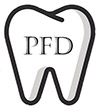
A tooth develops an abscess when the root or the space between tooth and gum becomes infected. Typically, this is caused by advanced tooth decay but can also occur when a tooth has been chipped or there is severe gingivitis. Any of these issues can cause bacteria to get past tooth enamel and cause an infection in the pulp. The bacteria can spread beyond the tooth into the jawbone.
Symptoms of a Tooth Abscess
An abscess presents as a continuous, throbbing toothache that may be accompanied by:
- A fever
- Pain while biting down or chewing
- Sensitivity when tooth is exposed to cold or heat
- A bitter taste in the mouth along with bad breath
- Swollen glands in the neck
- Red gums and swelling in the jaw
- A sore that drains from the side of the gum
- Feeling unwell and uneasy
If the infection kills the root of the tooth, the pain will go away, but the infection is still present and can continue to spread. This is why it is vital to see a dentist immediately if any of the above symptoms are present.
Diagnosis of a Tooth Abscess
A dentist will inspect the tooth with an instrument, which will cause the patient pain if an abscess is present. There will also be pain when the patient is asked to bite down. Red, swollen gums are also an indication of an infection. This will be confirmed through taking x-rays to inspect for bone erosion around the packet of bacteria.
Treatment of a Tooth Abscess
The goals of tooth abscess treatment are to clear the infection, save the tooth and prevent further complications. In some cases, the abscess will have to be drained through a root canal procedure or through a gum incision. Some patients may choose to have the tooth extracted. The dentist will prescribe antibiotics to resolve the infection, and patients can take over-the-counter pain relievers to keep discomfort to a minimum while the mouth heals.
The best way to prevent a tooth abscess is by daily brushing and flossing and seeing the dentist right away if a tooth is chipped or damaged.
